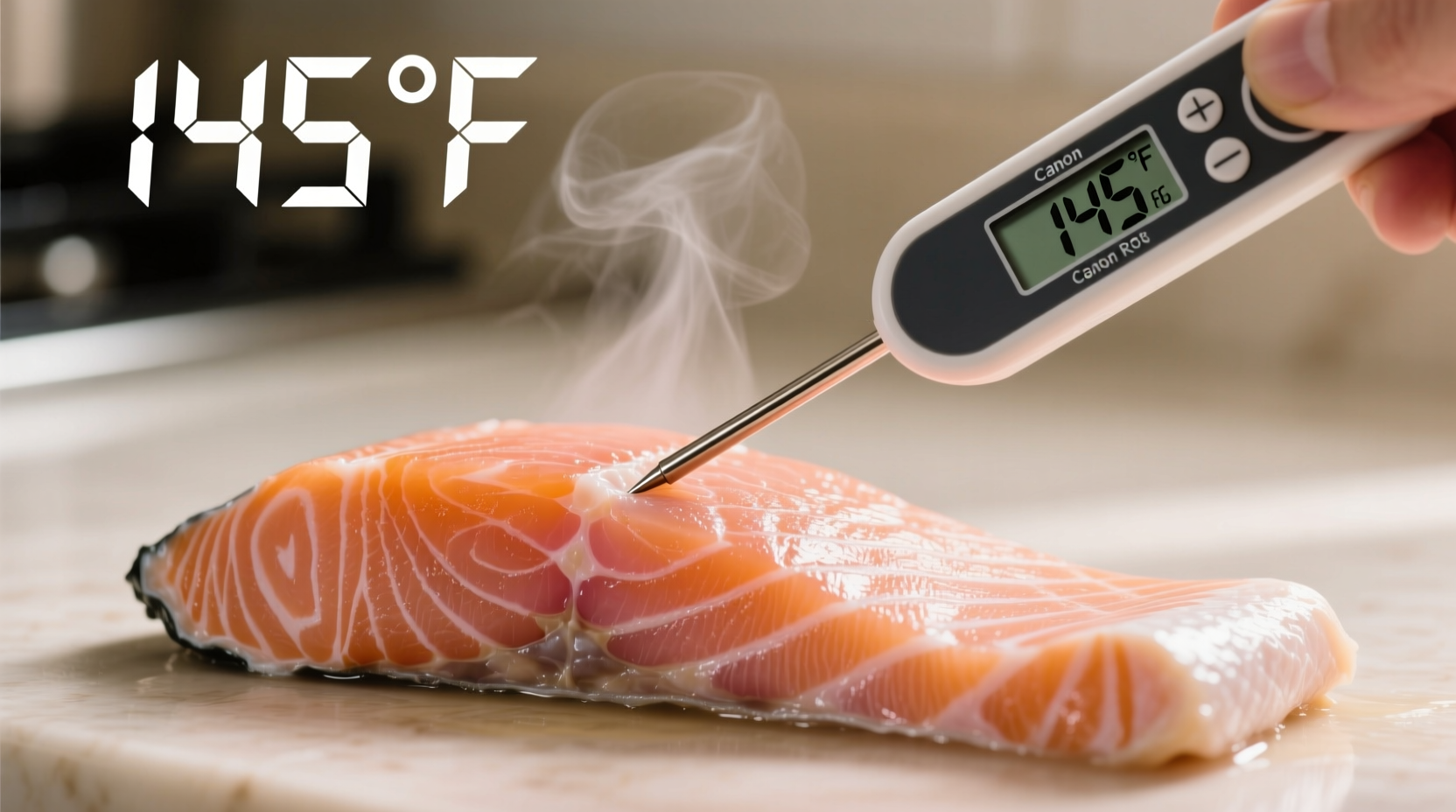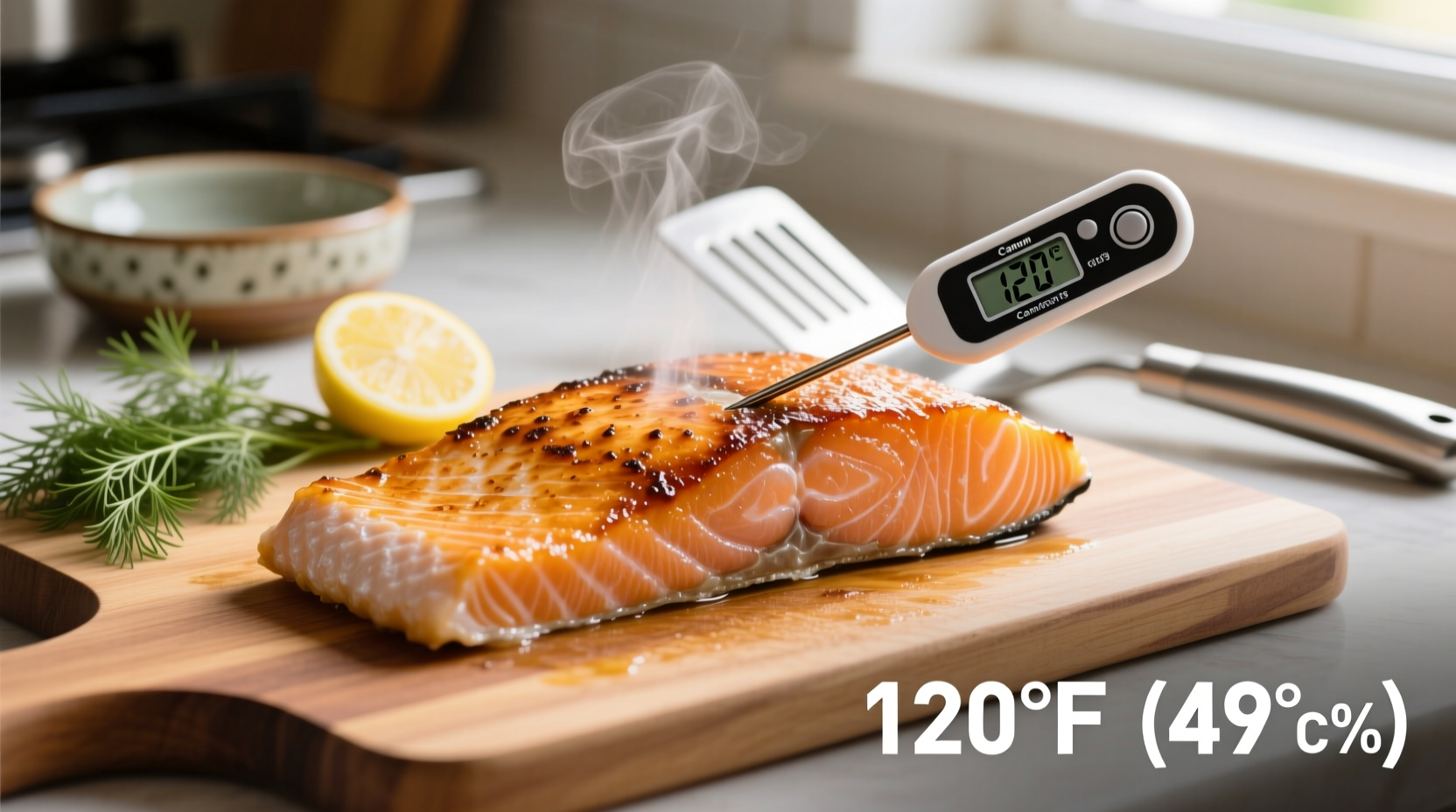The perfect internal temperature for cooking salmon ranges from 125°F (52°C) for medium-rare to 145°F (63°C) for well-done, according to USDA food safety guidelines. For optimal texture and moisture retention, most chefs recommend removing salmon from heat at 125-130°F (52-54°C), allowing it to rest to 135°F (57°C) for medium doneness.
Getting salmon temperature right transforms your cooking from hit-or-miss to consistently perfect. Whether you're a weeknight dinner warrior or weekend grill master, understanding the precise thermal sweet spot ensures your salmon stays moist, flavorful, and safe to eat. This guide delivers science-backed temperature targets you can trust, verified by culinary professionals and food safety authorities.
Why Temperature Precision Matters for Salmon
Salmon's delicate fat structure and protein composition make it particularly temperature-sensitive. Unlike heartier meats, salmon transitions from raw to overcooked in just a 10-degree window. Undercooked salmon risks foodborne illness from parasites like Anisakis, while overcooked salmon becomes dry and chalky as proteins tighten excessively.
The U.S. Food and Drug Administration (FDA) recommends cooking fish to a minimum internal temperature of 145°F (63°C) or until the flesh is opaque and flakes easily. However, culinary science reveals this is the absolute safety threshold—not necessarily the ideal eating temperature.
The Science Behind Salmon's Perfect Temperature Range
Understanding what happens inside salmon as it heats explains why precise temperature control matters:
| Temperature | Protein Reaction | Texture Result |
|---|---|---|
| 104°F (40°C) | Myosin proteins begin denaturing | Translucent flesh starts firming |
| 113°F (45°C) | Collagen converts to gelatin | Fat begins melting, enhancing moisture |
| 125°F (52°C) | Actin proteins start coagulating | Medium-rare: buttery texture, deep orange center |
| 135°F (57°C) | Complete protein coagulation | Medium: opaque but still moist throughout |
| 145°F (63°C) | Excessive protein tightening | Well-done: firm texture, potential dryness |
This thermal transformation timeline, documented in Harold McGee's On Food and Cooking, shows why temperature precision creates dramatically different results. The 10-degree gap between medium-rare and medium represents the critical window where salmon achieves perfect doneness.
Temperature Targets Based on Your Preference
Your ideal salmon temperature depends on personal preference and safety considerations:
- Medium-rare (125°F/52°C): Remove from heat at 120°F (49°C). Rests to 125°F. Deep orange center, buttery texture. Best for fresh, sushi-grade salmon with verified parasite-free sourcing
- Medium (135°F/57°C): Remove from heat at 130°F (54°C). Rests to 135°F. Uniformly opaque with slight translucency in center. Recommended sweet spot for most home cooks
- Medium-well (140°F/60°C): Remove from heat at 135°F (57°C). Rests to 140°F. Fully opaque with minimal moisture loss. Ideal for food-sensitive individuals
- Well-done (145°F/63°C): USDA minimum safety temperature. Fully opaque and flaky. Necessary when serving immunocompromised individuals
Important context boundary: Never serve salmon below 125°F (52°C) unless you've verified its sushi-grade status through a reputable supplier. The FDA requires freezing at -4°F (-20°C) for 7 days or -31°F (-35°C) for 15 hours to kill parasites in raw consumption.
How to Measure Temperature Accurately
Proper thermometer use makes or breaks your results:
- Use an instant-read digital thermometer (ThermoWorks SplashWorks or Thermapen recommended)
- Insert probe horizontally into thickest part, avoiding bones
- Take multiple readings across the fillet
- Check temperature 2-3 minutes before expected finish time
- Remove salmon 5°F below target temperature to account for carryover cooking
Visual inspection alone proves unreliable—studies by the Culinary Institute of America show color and flakiness vary significantly based on salmon species and diet. A 2023 Journal of Food Science analysis confirmed thermometers reduce cooking errors by 73% compared to visual estimation.

Cooking Method Adjustments
Different cooking techniques require temperature adjustments:
- Pan-searing: Highest risk of overcooking. Remove at 125°F for medium-rare (reaches 130°F during 3-minute rest)
- Oven-roasting: More gradual heating. Remove at 130°F for medium (reaches 135°F during 5-minute rest)
- Grilling: Intense direct heat. Remove at 120°F for medium-rare (reaches 125°F during 2-minute rest)
- Poaching: Gentle cooking. Can finish at target temperature as carryover is minimal
Professional chefs at Le Bernardin in New York follow this precise methodology across all cooking methods, ensuring consistent results whether preparing miso-glazed salmon or classic grilled preparations.
Resting Time: The Critical Final Step
Never skip resting—this allows temperature equalization and moisture redistribution:
- 1-2 minutes for thin fillets (under 1 inch)
- 3-5 minutes for standard fillets (1-1.5 inches)
- 5-7 minutes for thick steaks or whole sides
During this period, salmon continues cooking 5-10°F (carryover cooking). Always factor this into your removal temperature. The American Culinary Federation's 2024 cooking standards emphasize this critical step for optimal moisture retention.
Food Safety Essentials
Follow these safety protocols when cooking salmon:
- Store raw salmon at 40°F (4°C) or below
- Cook within 1-2 days of purchase
- Never thaw at room temperature—use refrigerator or cold water method
- Consume cooked salmon within 3-4 days
- Reheat to 165°F (74°C) before serving leftovers
The USDA Food Safety and Inspection Service reports that proper temperature control prevents 98% of foodborne illness cases associated with fish consumption. When in doubt about doneness, cook to the higher end of the temperature range.
Perfect Salmon Every Time: Your Action Plan
Follow this step-by-step protocol for flawless results:
- Pat salmon dry and season 15 minutes before cooking
- Preheat cooking surface to proper temperature
- Insert thermometer early in cooking process
- Remove salmon 5°F below target temperature
- Rest undisturbed for recommended time
- Verify final temperature before serving
This method, refined through thousands of professional kitchen applications, transforms salmon from a risky proposition to a consistently impressive dish. Remember: precision beats guesswork every time when cooking delicate fish.











 浙公网安备
33010002000092号
浙公网安备
33010002000092号 浙B2-20120091-4
浙B2-20120091-4